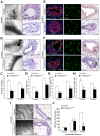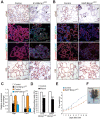The transcriptional repressor Blimp1 is expressed in rare luminal progenitors and is essential for mammary gland development
- PMID: 27190036
- PMCID: PMC4874485
- DOI: 10.1242/dev.136358
The transcriptional repressor Blimp1 is expressed in rare luminal progenitors and is essential for mammary gland development
Abstract
Mammary gland morphogenesis depends on a tight balance between cell proliferation, differentiation and apoptosis, to create a defined functional hierarchy within the epithelia. The limited availability of stem cell/progenitor markers has made it challenging to decipher lineage relationships. Here, we identify a rare subset of luminal progenitors that express the zinc finger transcriptional repressor Blimp1, and demonstrate that this subset of highly clonogenic luminal progenitors is required for mammary gland development. Conditional inactivation experiments using K14-Cre and WAPi-Cre deleter strains revealed essential functions at multiple developmental stages. Thus, Blimp1 regulates proliferation, apoptosis and alveolar cell maturation during puberty and pregnancy. Loss of Blimp1 disrupts epithelial architecture and lumen formation both in vivo and in three-dimensional (3D) primary cell cultures. Collectively, these results demonstrate that Blimp1 is required to maintain a highly proliferative luminal subset necessary for mammary gland development and homeostasis.
Keywords: 3D culture; Blimp1; Lumen formation; Luminal progenitors; Mammary gland morphogenesis; Mouse; Polarity; Prdm1; Transcriptional repressor.
© 2016. Published by The Company of Biologists Ltd.
Conflict of interest statement
The authors declare no competing or financial interests.
Figures








References
-
- Arulanandam R., Batenchuk C., Angarita F. A., Ottolino-Perry K., Cousineau S., Mottashed A., Burgess E., Falls T. J., De Silva N., Tsang J. et al. (2015). VEGF-mediated induction of PRD1-BF1/Blimp1 expression sensitizes tumor vasculature to oncolytic virus infection. Cancer Cell 28, 210-224. 10.1016/j.ccell.2015.06.009 - DOI - PubMed
-
- Bernardo G. M., Lozada K. L., Miedler J. D., Harburg G., Hewitt S. C., Mosley J. D., Godwin A. K., Korach K. S., Visvader J. E., Kaestner K. H. et al. (2010). FOXA1 is an essential determinant of ERalpha expression and mammary ductal morphogenesis. Development 137, 2045-2054. 10.1242/dev.043299 - DOI - PMC - PubMed
Publication types
MeSH terms
Substances
Grants and funding
LinkOut - more resources
Full Text Sources
Other Literature Sources
Medical
Molecular Biology Databases

